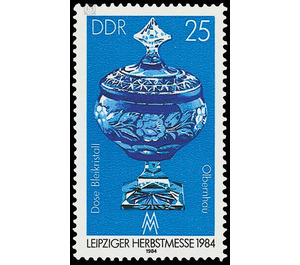Commemorative stamp series - Germany / German Democratic Republic 1984 - 25 Pfennig
Theme: Calender
| Country | Germany / German Democratic Republic |
| Issue Date | 1984 |
| Face Value | 25.00 |
| Color | blue |
| Perforation | K 14 |
| Printing Type | Rotogravure 2 |
| Stamp Type | Postage stamp |
| Item Type | Stamp |
| Chronological Issue Number | 2634 |
| Chronological Chapter | GER-DDR |
| SID | 119809 |
| In 16 Wishlists | |
Leipzig Autumn Fair 1984 At the Leipzig Autumn Fair in 1984, the Ministry of Posts and Telecommunications of the German Democratic Republic publishes two multicolored postage stamps. Special cancellation from 28th August to 27th October 1984 25 Pfennig value: lead crystal tin from Olbernhau The history of the European glass industry, from Venice over the Rhineland to the Thuringian Forest and the Ore Mountains, goes back to around 1600. The Saxon huts of the Erzgebirge and Vogtlandes reached their heyday in the 17th century. The Saxon glasscut was also motivated by the representative need of August the Strong. Well-known scientists and researchers such as Ehrenfried Walther von Tschirnhaus and Johann Friedrich Böttger greatly influenced porcelain and glass art. One of the first glassworks in the Erzgebirge was the Weitersglashütte on the trade route Schneeberg-Eibenstock-Karlsbad, it was built in 1624. It followed glassworks on the crest of the Erzgebirge, especially in today's circles Aue, Annaberg and Marienberg. Secured information is available for a total of thirteen workshops. In the Marienberg area, Saxon glass art found a new home in the present VEB Glaswerk Olbernhau, an operation of the VEB Kombinat Lausitzer Glas Weißwasser. With the involvement of Saxon processing companies in the VEB Kombinat Lusatian Glass of White Water, the traditional Saxon glass cut on Lusatian forms of huts finds a wide field of activity. In Olbernhau, a treasure trove with predominantly classic cut decorations is preserved. In this area, Saxon glass cutters and glass painters had already made outstanding achievements in the 17th and 18th centuries. The VEB Glaswerk Olbernhau is a company of international standing. The assortment comprises mainly the treatment of lead crystal hand blown healing and overlay (colored), in brilliant cuts as vases, bowls, goblets, ensembles. In part, articles are combined with engravings in floral motifs or from hunting scenes to very high-quality signed figurative copper engravings, designed by renowned artists of the GDR like Prof. Werner Klemke. The versatility of the production program also results from the application of traditional, historically grown techniques such as sandblast, yellow and red stain as well as the high-quality gold trim. The further glass finishing is done by engraving and grinding. The classical assortment includes the tin made of colored lead crystal, No. 1791: 2514 / G, decorated with a deep cut and engraved ribbon. It is available in several colors and is one of the top products in the range of more than 1,000 articles. The base-cut foot and the elegant faceted long button are brightly polished, while the can body is covered with colored glass. The removal of the overlap during the grinding process produces the high-contrast effect. The strong plastic rose engraving is enhanced by frosted and polished cuts.


